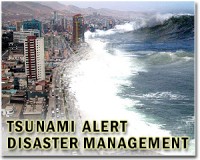 |
Tokyo (AFP) Feb 28, 2010 Japan imposed a mass tsunami evacuation on Sunday but fears of destructive waves triggered by Chile's killer earthquake ebbed across the rest of the Pacific Ocean's vast "Ring of Fire". Evacuation orders forced at least 320,000 people away from areas on Japan's east coast as oceanic surges up to 1.20 metres (four feet) high slammed ashore. A port area in the northern city of Nemuro was flooded. "Please do not approach the coast at any cost," Prime Minister Yukio Hatoyama warned in a nationally televised address. But Russia cancelled its own tsunami warning after only minor waves reached the Kamchatka peninsula, while doughty swimmers and surfers in Australia defied official warnings and flocked to the beach. Warning sirens had wailed as about 50 countries and territories along an arc stretching from New Zealand to Japan went on alert, five years after the Indian Ocean tsunami disaster that killed more than 220,000 people. Waves pummelled Chile and rolled through into Hawaii, French Polynesia and the South Pacific as the tsunami moved at jet-speed across the giant ocean after Saturday's 8.8-magnitude quake, which left at least 300 people dead. Five people were killed on the remote Robinson Crusoe archipelago far off the coast of Chile, the first reported tsunami casualties, but elsewhere no significant damage was reported and surges of water were smaller than expected. In Japan, one of the world's most quake-prone nations, authorities were taking no chances with the mass evacuation. Residents took shelter on higher ground as sea gates in fishing ports slammed shut and boats steamed home. Along with Russia, Japan lies on the outer edge of the "Ring of Fire", a belt of seismic fury responsible for most of the world's tremors and volcanoes. The Hawaii-based Pacific Tsunami Warning Center lifted its tsunami warning for everywhere except Japan and Russia. Thousands in 19 Philippine provinces who had voluntarily fled were free to return home, officials said. The Chilean disaster revived raw memories for Japan, where 140 lives were lost in 1960 when a 9.5-magnitude earthquake in the South American nation -- the largest on record -- sent a tsunami roaring across the Pacific. The Hawaii centre, set up by Pacific governments after the 1960 tsunami, had warned of possible "widespread damage" from waves as high as three metres. In Hawaii itself, the tsunami led to the evacuation of thousands of people and triggered panic buying of food, water and fuel. But there was little damage in the event. US President Barack Obama, who was born in Hawaii, had warned that the US western seaboard might see dangerous waves and currents throughout the day. "In the hours ahead, we'll continue to take every step possible to prepare our shores and protect our citizens," he said. One tsunami nearly 2.5 metres high slammed into Talcahuano, one of about 11 coastal towns in Chile pounded by the surge. Trawlers were sent shooting inland to the town square, where they lay marooned next to abandoned cars. Chilean President Michelle Bachelet announced a partial evacuation of Easter Island, but the island of about 4,000 people, known for its monolithic stone statues, received a relatively small onrush of water. In the island paradise of French Polynesia schools were closed, the port in Papeete was evacuated and thousands in Tahiti's hillside areas were taken to safety as the waves hit. Waves up to 1.5 metres high rammed New Zealand's eastern Chatham Islands. In Australia, the size of the surge dropped to around 40 centimetres although strong currents rolled up the east coast. Lorentz Engdahl, a regular on Sydney's famed Bondi Beach, was one of many to brave the warnings and take a sea dip, as hundreds rushed to outlooks along the Australian coast to watch for outsized waves. "The biggest danger right now are the blue bottles," Engdahl said in reference to the stinging jellyfish that are a common nuisance on Australian beaches. People in Tonga and the Cook Islands fled to higher ground, still jittery after a South Pacific tsunami killed more than 180 in September. burs/jit/pst
Share This Article With Planet Earth
Related Links Bringing Order To A World Of Disasters When the Earth Quakes A world of storm and tempest
 Hawaii Spared As Japan, Russia, Philippines Evacuate Coastlines
Hawaii Spared As Japan, Russia, Philippines Evacuate CoastlinesTokyo (AFP) Feb 28, 2010 Japan issued a major tsunami alert for its Pacific coastline Sunday after the massive earthquake in Chile, and ordered more than 10,000 people to evacuate vulnerable areas. The Japan Meteorological Agency warned that waves of up to three metres (10 feet) could hit the northern areas of Aomori, Iwate and Miyagi, even as fears of destructive waves eased across the rest of the Pacific. The ... read more |
|
| The content herein, unless otherwise known to be public domain, are Copyright 1995-2010 - SpaceDaily. AFP and UPI Wire Stories are copyright Agence France-Presse and United Press International. ESA Portal Reports are copyright European Space Agency. All NASA sourced material is public domain. Additional copyrights may apply in whole or part to other bona fide parties. Advertising does not imply endorsement,agreement or approval of any opinions, statements or information provided by SpaceDaily on any Web page published or hosted by SpaceDaily. Privacy Statement |